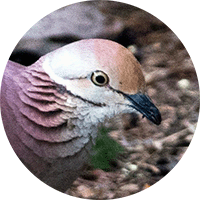Lined Quail-dove
The Lined Quail-Dove (Zentrygon linearis) Read in Spanish
Appearance: The Lined Quail-Dove is a medium-sized dove with a distinctive appearance. It has intricate black and white striping on its neck, leading to its name. The bird's overall plumage is a mix of brown, gray, and tawny shades, giving it a subtle yet striking look. It has red legs and a red bill, adding a pop of color to its muted feathers.
Habitat: Lined Quail-Doves are typically found in humid montane forests and cloud forests, much like the White-throated Quail-Dove. They inhabit dense vegetation at higher elevations, often around 1000 to 2000 meters in the Colombian Andes. These doves prefer areas with ample fruit-bearing trees, undergrowth, and water sources.
Behavior: Lined Quail-Doves are known for their secretive and elusive behavior. They are typically shy and stay hidden in the forest understory, foraging for fruits, seeds, and insects on the ground. These doves are often solitary or found in pairs, only coming together during the breeding season or when foraging in areas with abundant food resources.
Breeding: During the breeding season, Lined Quail-Doves build delicate nests in trees or shrubs, where the female lays one or two eggs. Both parents take part in incubating the eggs and caring for the young chicks. The chicks are precocial and can leave the nest shortly after hatching, although they still depend on their parents for feeding and protection.
Conservation Status: The conservation status of the Lined Quail-Dove in Colombia is of concern due to habitat loss, deforestation, and potential impacts from climate change.
Distribution
The Lined Quail-Dove (Zentrygon linearis) is primarily found in Colombia within specific geographic regions.
Central Andes: In the central parts of the Colombian Andes, the Lined Quail-Dove can be found in regions like the department of Tolima and the Nevado del Ruiz National Park. These areas provide important breeding and foraging grounds for the species.
Northern Andes: Some populations of the Lined Quail-Dove may also occur in the northern reaches of the Colombian Andes, particularly in areas within the departments of Norte de Santander and Santander. The presence of suitable habitat and food sources in this region supports the species' distribution.
Taxonomy
The Lined Quail-Dove (Zentrygon linearis)
- Kingdom: Animalia
- Phylum: Chordata
- Class: Aves (Birds)
- Order: Columbiformes
- Family: Columbidae
- Genus: Zentrygon
- Species: Zentrygon linearis
Vocalization
The Lined Quail-Dove (Zentrygon linearis)
- Song: The Lined Quail-Dove's song is a series of melodic, mournful coos and whistles that are repeated at intervals. The song is typically soft and low-pitched, carrying through the forest understory. It is a soothing and peaceful sound that can often be heard echoing through the trees of the montane and cloud forests where these doves reside.
- Call: In addition to its song, the Lined Quail-Dove produces various calls for different purposes. The calls of the Lined Quail-Dove can range from gentle coos to sharper, more emphatic notes used during interactions with other doves or to signal alarm. These calls help the doves communicate with each other and maintain social cohesion within their territories.
- Territorial Displays: During territorial displays or courtship rituals, the Lined Quail-Dove may intensify its vocalizations, incorporating a mix of coos, purrs, and trills to attract mates or establish dominance within its territory. These displays often involve intricate vocal exchanges between individuals and are essential for pair bonding and breeding success.
- Communications: Vocalizations also play a crucial role in maintaining contact between mated pairs and family members, especially when foraging or moving through the dense forest undergrowth. The unique vocal repertoire of the Lined Quail-Dove helps individuals stay connected and coordinate their movements in their forest habitat.



